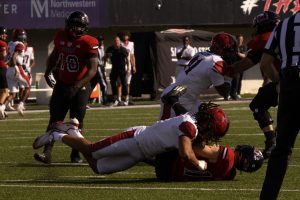NIU changing harassment policy
October 15, 1987
Normal- NIU’s sexual harassment procedures are too complex and the university is drafting changes in its policy, NIU officials reported Wednesday.
eports from the three Regency schools—NIU, Illinois State University and Sangamon State University—were received by the Board of Regents at its Student Affairs Committee meeting.
Jon Dalton, vice president for student affairs, said NIU adopted its sexual harassment policy in 1982. While the policy and procedures meet the board’s requirements, he said the procedures for persons who believe they have been harassed are “somewhat complex.”
The procedures call for too many categories of complaints, Dalton said. “There are categories for student vs. student, faculty vs. faculty, and staff vs. staff.” There also are different procedures for crossing categories, such as student vs. faculty, he said. A new sexual harassment policy is being drafted by the Affirmative Action Office, which will address the problem of too many categories, Dalton said.
NIU is not able to provide committee members with the number of sexual harassment cases reviewed each year because there are two types of harassment complaints, Dalton said.
There are no formal records kept on the number of informal complaints, which are handled through a number of NIU offices, including the ombudsman, the NIU Judicial Office, department chairmen, college deans and counselors, he said. “We’ve had about 30 to 40 informal inquiries over the past 3 to 4 years,” Dalton said.
NIU President John LaTourette said the number of formal complaints which are handled through the Affirmative Action Office cannot be obtained because of inadequate records. “We (NIU) have not had a permanent affirmative action director since January of 1984,” he said, adding the new director has been unable to find a record of formal complaints.
“We will institute a means by which the Affirmative Action Office will receive information (on sexual harassment complaints) on a periodic basis,” LaTourette said.
Dalton told the committee NIU does not have problems distributing information about its harassment policies and procedures. A brochure on the policy and procedures has been circulated to student organizations, residence halls, counselors and university offices, he said.
LaTourette said national regulations encourage more than one access point for persons with complaints because people might be reluctant to provide information to some offices, he said.
Students are informed of the policy through the Student Judicial Code, the Guide to Residence Living, publication in The Northern Star and mailings to students and organizations, Dalton said. “I don’t know how we could do it (distribute information) better.”
Dalton said “Sexual assault is a very very serious problem at Northern and other colleges.” NIU has developed some sexual assault education programs and circulates a pamphlet, he said.
ISU President Lloyd Watkins said of the 15 sexual harassment complaints at ISU since 1984, five have occurred this year, he said.
ISU Affirmative Action Officer Gloria Davis said the number of complaints has increased this year because of increased efforts to distribute information on ISU’s policies. ISU’s policy is included in employer and employee handbooks, each semester’s schedule of classes and the college newspaper, Davis said. In addition, residence halls conduct programs on sexual assault, she said.
“The increase in the number of reported (sexual harassment) cases is some feedback that we’re getting the word out. But, I don’t believe all cases are reported,” Davis said.
SSU President Durward Long said there have been no formal complaints of sexual harassment there in recent years.
Long said SSU’s student body differs from NIU’s and ISU’s because the students are older and “more experienced in dealing with these issues.” Most of SSU’s students live off campus and deal with sexual harassment through off-campus authorities, he said.
egents Chancellor Roderick Groves said, “Procedures must be tailor-made to each campus. It would be a mistake to put them in one mode.”






